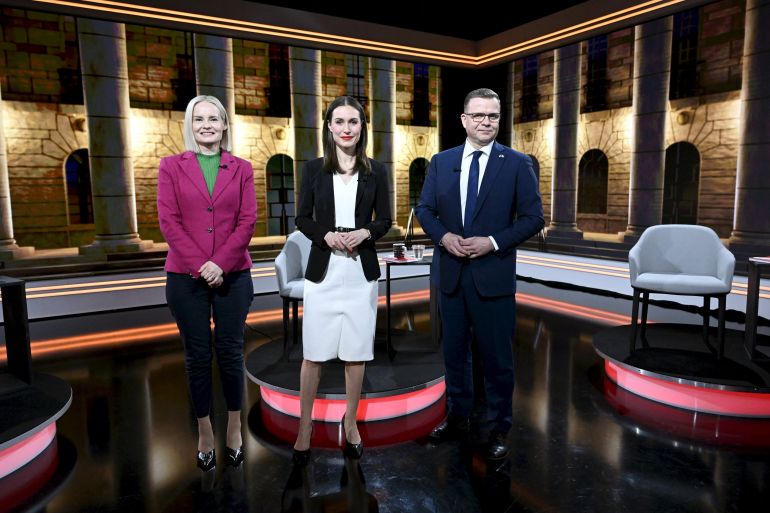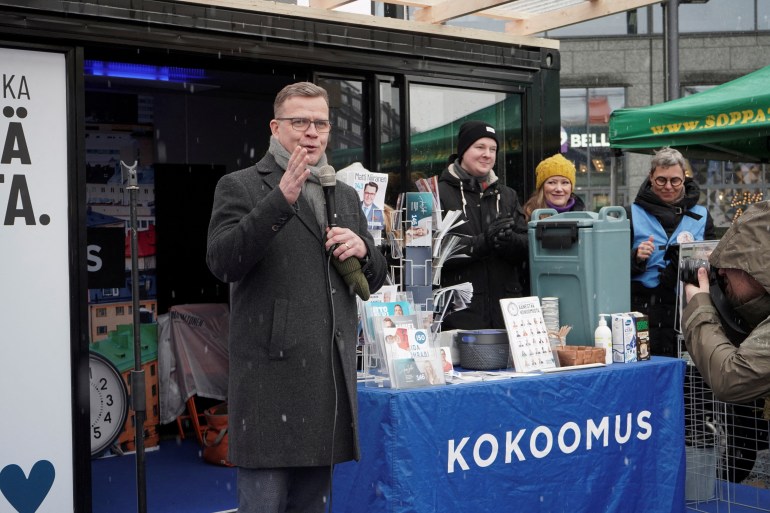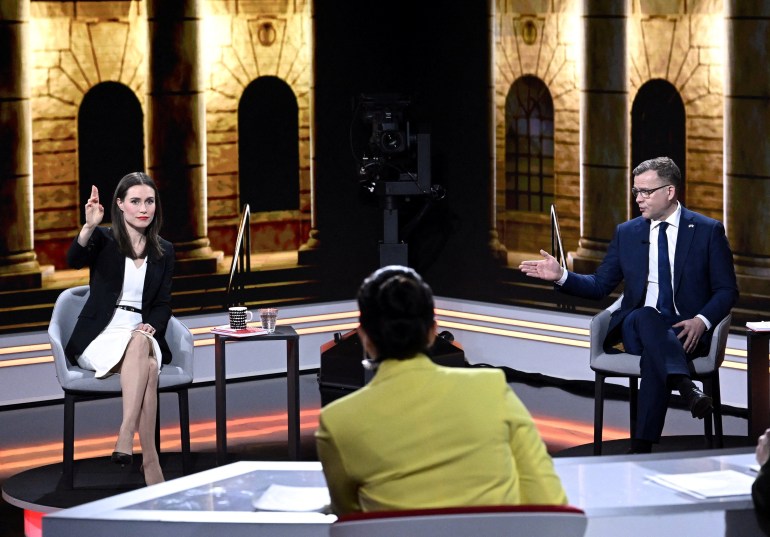Finland, having cleared last NATO hurdle, heads to elections
Is Sanna Marin still popular and do most Finns support NATO? Here are five key things to know.

Finland, which shares a long border with Russia, heads to the polls on Sunday to elect a new government as it prepares to join NATO.
On Thursday, Turkey ratified the Nordic nation’s membership – the last of the alliance’s 30 members to do so.
Keep reading
list of 4 itemsErdogan says Turkey may accept Finland in NATO, but block Sweden
UN says Finland violated child rights in Syria camps
Finland puts journalists on trial for revealing defence secrets
Will Prime Minister Sanna Marin’s Social Democratic Party, which started the membership process last year, take the country of 5.5 million people into the world’s largest military alliance?
And is Marin still as popular as she was in 2019 when she became the world’s youngest leader at 34?
Here’s what you should know:
How is the government formed?
Thousands of candidates from 22 political parties are vying for 200 seats in Finland’s one-chamber parliament, the Eduskunta.
Four groups tend to dominate elections: the Social Democrats, Centre Party, National Coalition Party and Finns Party.
Here is where eight parties lie on the political spectrum:
- Social Democratic Party of Finland (SDP) – Marin’s centre-left party, now the largest in parliament.
- Centre Party (KESK) – Finland’s fourth-largest party with centrist policies.
- National Coalition Party (KOK) – The main opposition group centre-right party, also described as conservative-liberal.
- Finns Party (PS) – Right-wing populists seeking cuts to immigration.
- Left Alliance (VAS) – Left-wing party that has faced divisions over Finland’s NATO membership.
- Green League (VIHR) – Environmentalists that prioritise welfare and equality.
- Swedish People’s Party of Finland (RKP) – Party representing the minority of Swedish speakers in Finland.
- Christian Democrats (KD) – Party supporting “Christian values”.
The latest opinion poll published by the newspaper Helsingin Sanomat showed the three biggest parties – the National Coalition, Social Democrats and Finns Party – neck and neck.
The party that wins the most seats may form the next government.
To do so, it needs to form a coalition with other parties and secure at least 101 seats. The leader of the winning party becomes prime minister.

Is Marin still popular?
Marin’s government is a coalition made up of her Social Democrats, the Centre Party, Green League, Left Alliance and Swedish People’s Party.
She faces stiff competition, especially from Petteri Orpo from the National Coalition and the Finns Party’s Riikka Purra.
During Marin’s tenure, she has become known for her straightforward politics, modern feminist ideals and cool persona. Last year, she was widely criticised by some members of the opposition after a video of her partying with her friends went viral on social media.
But Helsinki voter Emma Holopainen told Al Jazeera that the scandal will not harm Marin’s chances.
“A lot of the critiques towards her have been about her personal life and choices and not directly related to her leadership skills,” she said.
Marianna, a 27-year-old, shared a similar view.
“For the first time ever,” she said, “people are talking about ‘voting tactically’ for the Social Democrats as they want Sanna Marin to continue being prime minister although they would normally vote for a different party, such as the Greens.
“The SDP is behind the KOK by a small margin in the polls and people would much rather see Marin continue as the prime minister.”
On election day, Finns traditionally enjoy a coffee and sweet bun called “pulla” after they vote.
“On Instagram, there was also a post circulating, explaining how you can tell what party someone votes for by the pulla – cinnamon bun – they have after voting,” Marianna said.
What do Finns think of NATO?
According to Theodora Helimäki, a doctoral candidate studying voting behaviour at the University of Helsinki, joining NATO is something all parties agree on.
“Historically, joining NATO prior to Russia’s war in Ukraine was a divisive topic for some people in the country,” Holopainen said. “NATO is quite popular now, and more people are in favour of it.”
A poll by the broadcasting company YLE in May showed that 76 percent of Finns were in favour of joining NATO.
The Left Party, once a staunch opponent of Finland’s entry into NATO, now backs membership as a defensive move.
According to local media, the war in Ukraine was one of the main reasons behind this sharp shift among leftists.
Marianna told Al Jazeera that she supports joining NATO.
“Before February 24, 2022, if any left-wing young person was asked about Finland joining NATO, the response would have been negative,” she said, referring to the date of Russia’s full-scale invasion of Ukraine.
“We wanted to remain unaligned. We didn’t want to spend our money on defence or send our men to train with the alliance.
“But there’s a lot of collective historical trauma with Russia, which we inherited from our grandparents’ generation, and we have realised that there’s only one option now, which is to join NATO.”
How does voting work?
Members of parliament are elected from 13 electoral districts. The number of representatives elected from each district is in proportion to the district’s population.
Voters choose candidates – who are ranked according to their popularity – from an open list and the ones with the most votes in each district win seats.
“It’s like we have 13 mini-elections to decide the winners of the Parliament,” Helimäki said.
Finns living abroad may vote in advance and send in absentee ballots by post.
According to Helimäki, pre-voting in Finland has become more popular this year. It can be done in libraries, universities and some grocery stores.
What do Finns care about?
The fallout from the COVID-19 pandemic and addressing security concerns with Russia have been Marin’s main challenges since she began her term.
This year, voters are also more concerned about how the government plans to tackle inflation and address climate change, Helimäki said.
According to Statistics Finland, inflation rose to 8.8 percent in February, driven by higher mortgage interest rates and pricier heating bills.
Like in the rest of Europe, the cost-of-living crisis is a worry.
Moreover, at the end of January, Finland’s national debt stood at about 144bn euros ($157bn). Debt started rising during the pandemic and after Russia invaded Ukraine. It increased with the government borrowing more money to fortify its defence systems.
Finance Minister Annika Saarikko has warned that the next government might have to borrow further.
Opposition leader Orpo told the Reuters news agency that cutting unemployment, welfare benefits and business subsidies could rebalance the economy.
But Marin’s government has opposed spending cuts as a solution to the debt crisis and instead suggested raising taxes and encouraging economic growth.

As for climate change, Purra of the Finns Party said in a recent debate that Finland’s 2035 carbon neutrality target – which was a goal set by Marin’s government and which the KOK party also agrees with – should be delayed until 2050.
“Some Finns, especially from the forestry sector, aren’t very pleased with this statement,” Helimäki said. “Sixty percent of the forests in Finland are under private ownership, so they are concerned that such messages from political parties could result in more deforestation and environmental degradation.”
The Finns Party’s campaign has also focussed on opposing immigration.
Marin has referred to the Finns Party as “openly racist” and said she would not form a coalition with the populists.
“It’s quite disappointing to see that immigration is still a topic of contention,” said Holopainen, the voter from Helsinki.